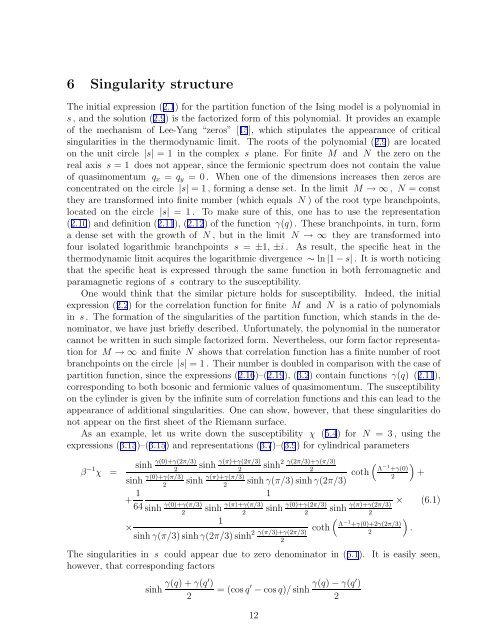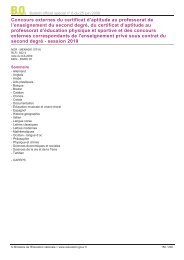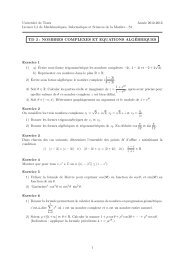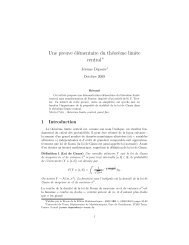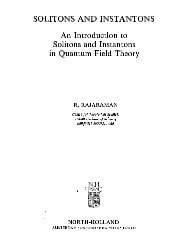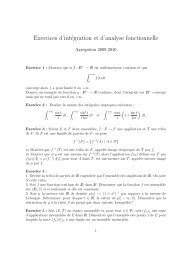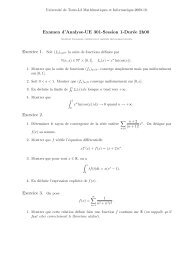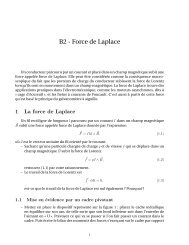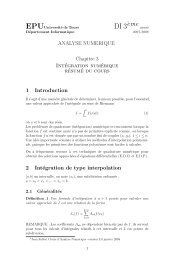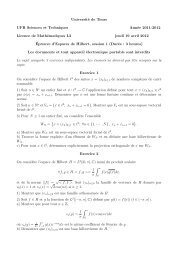Magnetic susceptibility of the two-dimensional Ising model ... - LMPT
Magnetic susceptibility of the two-dimensional Ising model ... - LMPT
Magnetic susceptibility of the two-dimensional Ising model ... - LMPT
Create successful ePaper yourself
Turn your PDF publications into a flip-book with our unique Google optimized e-Paper software.
6 Singularity structure<br />
The initial expression (2.1) for <strong>the</strong> partition function <strong>of</strong> <strong>the</strong> <strong>Ising</strong> <strong>model</strong> is a polynomial in<br />
s, and <strong>the</strong> solution (2.9) is <strong>the</strong> factorized form <strong>of</strong> this polynomial. It provides an example<br />
<strong>of</strong> <strong>the</strong> mechanism <strong>of</strong> Lee-Yang “zeros” [15], which stipulates <strong>the</strong> appearance <strong>of</strong> critical<br />
singularities in <strong>the</strong> <strong>the</strong>rmodynamic limit. The roots <strong>of</strong> <strong>the</strong> polynomial (2.9) are located<br />
on <strong>the</strong> unit circle |s| = 1 in <strong>the</strong> complex s plane. For finite M and N <strong>the</strong> zero on <strong>the</strong><br />
real axis s = 1 does not appear, since <strong>the</strong> fermionic spectrum does not contain <strong>the</strong> value<br />
<strong>of</strong> quasimomentum q x = q y = 0. When one <strong>of</strong> <strong>the</strong> dimensions increases <strong>the</strong>n zeros are<br />
concentrated on <strong>the</strong> circle |s| = 1, forming a dense set. In <strong>the</strong> limit M → ∞ , N = const<br />
<strong>the</strong>y are transformed into finite number (which equals N ) <strong>of</strong> <strong>the</strong> root type branchpoints,<br />
located on <strong>the</strong> circle |s| = 1 . To make sure <strong>of</strong> this, one has to use <strong>the</strong> representation<br />
(2.10) and definition (2.11), (2.12) <strong>of</strong> <strong>the</strong> function γ(q). These branchpoints, in turn, form<br />
a dense set with <strong>the</strong> growth <strong>of</strong> N , but in <strong>the</strong> limit N → ∞ <strong>the</strong>y are transformed into<br />
four isolated logarithmic branchpoints s = ±1, ±i . As result, <strong>the</strong> specific heat in <strong>the</strong><br />
<strong>the</strong>rmodynamic limit acquires <strong>the</strong> logarithmic divergence ∼ ln |1 − s| . It is worth noticing<br />
that <strong>the</strong> specific heat is expressed through <strong>the</strong> same function in both ferromagnetic and<br />
paramagnetic regions <strong>of</strong> s contrary to <strong>the</strong> <strong>susceptibility</strong>.<br />
One would think that <strong>the</strong> similar picture holds for <strong>susceptibility</strong>. Indeed, <strong>the</strong> initial<br />
expression (2.2) for <strong>the</strong> correlation function for finite M and N is a ratio <strong>of</strong> polynomials<br />
in s. The formation <strong>of</strong> <strong>the</strong> singularities <strong>of</strong> <strong>the</strong> partition function, which stands in <strong>the</strong> denominator,<br />
we have just briefly described. Unfortunately, <strong>the</strong> polynomial in <strong>the</strong> numerator<br />
cannot be written in such simple factorized form. Never<strong>the</strong>less, our form factor representation<br />
for M → ∞ and finite N shows that correlation function has a finite number <strong>of</strong> root<br />
branchpoints on <strong>the</strong> circle |s| = 1. Their number is doubled in comparison with <strong>the</strong> case <strong>of</strong><br />
partition function, since <strong>the</strong> expressions (2.16)–(2.19), (3.2) contain functions γ(q) (2.11),<br />
corresponding to both bosonic and fermionic values <strong>of</strong> quasimomentum. The <strong>susceptibility</strong><br />
on <strong>the</strong> cylinder is given by <strong>the</strong> infinite sum <strong>of</strong> correlation functions and this can lead to <strong>the</strong><br />
appearance <strong>of</strong> additional singularities. One can show, however, that <strong>the</strong>se singularities do<br />
not appear on <strong>the</strong> first sheet <strong>of</strong> <strong>the</strong> Riemann surface.<br />
As an example, let us write down <strong>the</strong> <strong>susceptibility</strong> χ (5.4) for N = 3 , using <strong>the</strong><br />
expressions (3.13)–(3.15) and representations (3.7)–(3.9) for cylindrical parameters<br />
β −1 χ =<br />
sinh γ(0)+γ(2π/3) sinh γ(π)+γ(2π/3) sinh 2 γ(2π/3)+γ(π/3) ( )<br />
2 2 2<br />
sinh γ(0)+γ(π/3) sinh γ(π)+γ(π/3) sinh γ(π/3) sinhγ(2π/3) coth Λ −1 +γ(0)<br />
+<br />
2<br />
2 2<br />
+ 1 1<br />
× (6.1)<br />
64 sinh γ(0)+γ(π/3) sinh γ(π)+γ(π/3) sinh γ(0)+γ(2π/3) sinh γ(π)+γ(2π/3)<br />
2 2 2 2<br />
1<br />
×<br />
sinh γ(π/3) sinhγ(2π/3) sinh 2 γ(π/3)+γ(2π/3)<br />
2<br />
coth<br />
(<br />
Λ −1 +γ(0)+2γ(2π/3)<br />
The singularities in s could appear due to zero denominator in (6.1). It is easily seen,<br />
however, that corresponding factors<br />
sinh γ(q) + γ(q′ )<br />
2<br />
= (cos q ′ − cos q)/ sinh γ(q) − γ(q′ )<br />
2<br />
12<br />
2<br />
)<br />
.


